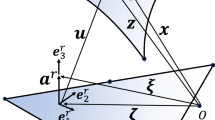Abstract
The paper presents an analytical constitutive design sensitivity analysis (DSA) algorithm for explicit dynamics of elastic-plastic finite rotation shells. Two explicit dynamical algorithms for finite rotation shells are presented, and the DSA is developed for the one formulated in terms of the rotation vector and its time derivatives, \(\{ \mathbf{\psi}, \mathbf{\dot{\psi}}, \mathbf{\ddot{\psi}}\}\). The hypo-elastic constitutive model based on the Green–McInnis–Naghdi stress rate is used to derive an incremental algorithm in terms of ‘back-rotated’ objects. The associative deviatoric Huber–Mises plasticity modified by plane stress conditions is implemented in the form suitable for finite rotation/small elastic strain increments. The analytical DSA is developed for the above-specified problem, with the design derivatives calculated w.r.t. material parameters. Design- differentiation of the dynamic algorithm and the scheme of handling the history data and the predicted values in differentiation, which is crucial in computing correct derivatives, are described. Besides, we show how to avoid Newton loops in the DSA algorithm, when such a loop is present in the constitutive algorithm. Numerical examples show that, despite a great complexity of the solution algorithm for the finite-rotation elastic-plastic shells, it is feasible to compute analytical design derivatives of very good accuracy.
Similar content being viewed by others
References
ABAQUS Explicit, v. 6.4. (2004) Abaqus Inc. (http://www.abaqus.com)
Bathe K-J, Dvorkin EN (1986) A formulation of general shell elements – The use of mixed interpolations of tensorial components. Int J Numer Methods Eng 22:697–722
Belytschko T, Liu JS, Moran B (2000) Nonlinear finite elements for continua and structures. Wiley, New York
Benson DJ, Hallquist JO (1986) A simple rigid body algorithm for structural dynamics programs. Int J Numer Methods Eng 22:723–749
Cho S, Choi KK (2000) Design sensitivity analysis and optimization of nonlinear transient dynamics. Part I – sizing design. Int J Numer Methods Eng 48:351–373
Cho S, Choi KK (2000) Design sensitivity analysis and optimization of nonlinear transient dynamics. Part II – configuration design. Int J Numer Methods Eng 48:375–399
Dienes JK (1979) On the analysis of rotation and stress rate in deforming bodies. Acta Mechanica 32:217–232
Hughes TJR (1984) Numerical implementation of constitutive models: rate independent deviatoric plasticity. In: Nemat-Nasser S et al (eds) Theoretical foundations for large-scale computing for nonlinear material behaviour. Nijhoff, The Hague, pp 29–57
Hughes TJR (1987) The finite element method. Linear static and dynamic finite element analysis. Prentice-Hall, Englewood Cliffs
Hughes TJR, Brezzi F (1989) On drilling degrees of freedom. Comput Methods Appl Mech Eng 72:105–121
Hughes TJR, Liu WK (1981) Nonlinear finite element analysis of shells. Part I. Three-dimensional shells. Comput Methods Appl Mech Eng 26:331–362
Hughes TJR, Liu WK, Levit I (1981) Nonlinear dynamic finite elements of shells. In: Wunderlich W, Stein E, Bathe KJ (eds) Nonlinear finite element analysis of plates and shells. Springer, Berlin Heidelberg New York
Hughes TJR, Winget J (1980) Finite rotation effects in numerical integration of rate constitutive equations arising in large-deformation analysis. Int J Numer Methods Eng 15:1862–1867
Jetteur P (1986) Implicit integration algorithm for plane stress elastoplasticity in plane stress analysis. Eng Comput 3:251–253
Key SW, Beisinger ZE (1971) The transient dynamic analysis of thin shells in the finite element method. In: Proceedings of the 3rd conference on matrix methods in structural mechanics, Wrigth-Patterson Air Force Base, Ohio
Kim NH, Choi KK, Chen JS (2001) Structural optimization of finite deformation elastoplasticity using continuum-based shape design sensitivity formulation. Comput Struct 79:1959–1976
Kim NH, Bae DS, Choi KK (2001) Configuration design sensitivity analysis of dynamics for constrained mechanical systems. Comput Methods Appl Mech Eng 190:5271–5282
Kleiber M, Hien TD, Antúnez H, Kowalczyk P (1997) Parameter sensitivity in nonlinear mechanics. Wiley, New York
Korelc J (2002) Multi-language and multi-environment generation of nonlinear finite element codes. Eng Comput 18:312–327
Kowalczyk P, Kleiber M (1999) Shape sensitivity in elasto-plastic computations. Comput Methods Appl Mech Eng 171:371–386
Simo JC, Fox DD, Hughes TJR (1992) Formulations of finite elasticity with independent rotations. Int J Numer Methods Eng 95:227–288
Simo JC, Hughes TJR (1998) Computational inelasticity. Springer, Berlin Heidelberg New York
Simo JC, Taylor RL (1985) Consistent tangent operators for a rate-independent elastoplasticity. Comput Methods Appl Mech Eng 48:101–118
Simo JC, Taylor RL (1986) A return mapping algorithm for plane stress elastoplasticity. Int J Numer Methods Eng 22:649–670
Stillman DW (2000) Design sensitivity analysis for structures using explicit time integration. In: 8th AIAA/USAF/NASA/ISSMO symposium on multidisciplinary analysis and optimization, 6–8 September 2000, Long Beach, CA, AIAA-2000-4906
Wisniewski K, Kowalczyk P, Turska E (2003) On the computation of design derivatives for Huber-Mises plasticity with non-linear hardening. Int J Numer Methods Eng 57:271–300
Wisniewski K, Turska E (2000) Kinematics of finite rotation shells with in-plane twist parameter. Comput Methods Appl Mech Eng 190(8–10):1117–1135
Wisniewski K, Turska E (2001) Warping and in-plane twist parameter in kinematics of finite rotation shells. Comput Methods Appl Mech Eng 190(43–44):5739–5758
Wisniewski K, Turska E (2002) Second order shell kinemtaics implied by rotation constraint equation. J Elasticity 67:229– 246
Whirley RG, Hallquist JO, Goudreau GL (1989) An assesment of numerical algorithms for plane stress and shell elastoplasticity on supercomputers. Eng Comput 6:116–126
Author information
Authors and Affiliations
Corresponding author
Rights and permissions
About this article
Cite this article
Wisniewski, K., Kowalczyk, P. & Turska, E. Analytical DSA for Explicit Dynamics of Elastic-plastic Shells. Comput Mech 39, 761–785 (2007). https://doi.org/10.1007/s00466-006-0068-3
Received:
Accepted:
Published:
Issue Date:
DOI: https://doi.org/10.1007/s00466-006-0068-3




